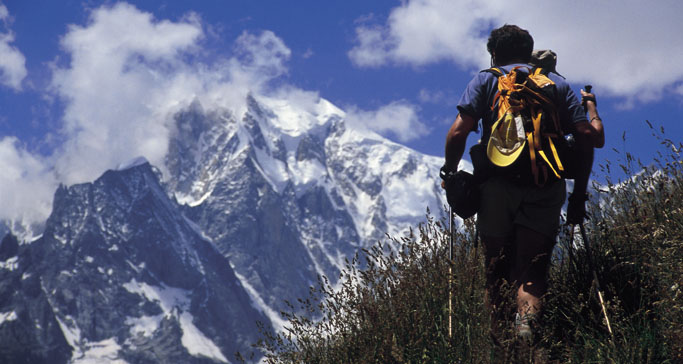History
For millennia, the region of the Valle d’Aosta was one of the main access routes between northern and southern Europe. Celtic people entered the area between the fifth and third centuries B.C, the Romans marched through leaving roads and bridges that are still visible today.
During the Middle Ages, pilgrims on their way to both the Middle East and Rome found their way through this small but important valley. The result is a network of centuries-old trade routes that provide unparalleled hiking through a region of the Italian Alps that remains extremely rich with old traditions and customs.
Originally, the Gran Paradiso National park existed as a hunting preserve for the French-speaking Dukes of Aosta. The preserve was later donated by King Vittorio Emanuele III, who gave his own hunting reserve to the state to become Italy’s first national park.
Today, the park encompasses approximately one-sixth of the regional territory and hosts over 4,000 steinbocks or big horned sheep. In addition to Steinbock, the Gran Paradiso provides a home for a number of protected species such as marmot, chamois, and ibex. Some hikers have even enjoyed glimpses of the rare ermine, ptarmigan, and golden eagle.
Location and Geography
Sheltered by the towering peaks of Europe’s highest peak, Mont Blanc, the Matterhorn, and Monte Rosa, the reaches of the Valle d’Aosta remain entirely mountainous. In the valley itself exists a unique culture, complete with battling cows, (an old Aosta tradition), Roman ruins and a hundred different castles. Glaciers, Gothic sculptures, Baroque village churches, numerous fortresses, spectacular views and glamorous ski resorts like Courmayeur and less crowded ski resorts like in Cogne and Champoluc also add to the mix. The food is hearty and the local inhabitants speak Patois, a dialect whose origins lie in Provence.
Some call this region the “Rome of the Alps” since the Valle d’Aosta has a milder, sunnier climate than the resorts on the other side of the peaks. Opposite the Valle d’Aosta lie the towns of the Valais in Switzerland and the Mont Blanc Massif in France.
To the south of the valley, the Gran Paradiso National Park forms an entirely different mountain range that offers an opportunity to enjoy some of the most remote, high altitude hiking in the Alps with an opportunity to witness an abundance of wildlife.
Since the region of the Valle d’Aosta and the accompanying Gran Paradiso exist as Italy’s most sparsely populated area, the soaring peaks, hidden valleys, expansive glaciers and treasures of wildlife still wait to be discovered and enjoyed.
Culture and Cuisine
Enjoy the local wine and beer at your rest stops throughout your trip.
Contrary to much of Italy, pasta is not a staple of the cuisine here. This regions’ cooking is based in warming soups bread, rice, potatoes, and gnocchi, and polenta. Dairy is a staple of the region- you can also find Swiss influence in fondue butter sauces. Enjoy game meats and hearty stews as you take in the beauty of the surrounding landscape.
The Aosta Valley was once an essential throughway to the alpine passes. Centuries of Roman inhabitants have left considerable impressions on the Aosta Valley in their city walls and architecture. The houses now are characteristic to the region in their use of wood and masonry- the villages are erected using natural elements from the alpine landscape.
Why You Should Book Now
With a number of carefully selected itineraries, hiking this majestic region will fulfill your wanderlust! Sneak through heavenly lush meadows and links fascinating and remote hamlets and hike challenging treks with breathtaking views. Our trips through Northern Italy fill up fast so book your dream adventure vacation while there is still availability!









Comments are closed.